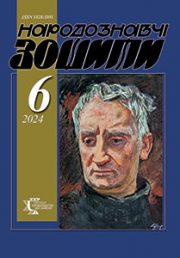The Ethnology Notebooks. 2017, 5 (137), 1149—1155
UDK 7. 046; 7.041.6
DOI https://doi.org/10.15407/nz2017.05.1149
ART WORKS OF TYMOTEI THE PAINTER, BURGHER OF RYBOTYCHI, 1660—1670
Kosiv Roksolana Romanivna, Ph.D. in Art Studies,
senior researcher at the Department of Old-Ukrainian Art
of the National Museum in Lviv named after Andrey Sheptytsky,
associate professor at the Department of Sacral Art
at the Lviv National Academy of Arts,
Kubiiovycha Str., 38, Lviv, 79011, Ukraine.
Contacts: Tel. (032) 2761482; e-mail: lanakosiv@yahoo.com
ORCID ID: https://orcid.org/0000-0002-1202-1488
Abstract. The Apostolic Prayer of 1673 by the master Tymotei (which, according to the signature, he wrote with brother in law) from the town Rybotychi near Peremyshl is considered. The Prayer is the oldest preserved monument with the author`s signature of the painter from this great and wellknown in the second half of XVII — XVIII centuries artistic centre of Nadsiannia. Attention is paid to the characteristic painting style of the work, which does not completely “fit” into the current concept of the Rybotychi masters. On the basis of study of the author`s handwriting, the unique cloth that was part of the iconostasis with the image of Holidays, Prayers and Prophetic Tires was also attributed to the Tymotei Rybotytskyi heritage. Both works are the source monuments that give an idea about the development of the stylistic of iconoclasm of the Rybotychi masters in the 1650—1670s.
Keywords: painter Tymotei, iconography stylistics, town Rybotychi, Rybotychi painting center, Apostolic Prayer of 1673.
Received 12.07.2017
REFERENCES
Natsional’na biblioteka u Varshavi. Viddil rukopysiv. Akty Hreko-Katolyts’koi kapituly (ABGK). — 12316 III. Reiestr bratstva molodshoho Rozhdestva Bohorodytsi v Peremyshli na peredmisti L’vivs’komu zvanomu Bolonytsia: 1640—1743 rr [in Ukrainian].
Aleksandrovych, V. (2002). Seredovysche ukrains’kykh maliariv Peremyshlia u XVII stolitti. Ukraina u Tsentral’noSkhidnij Evropi (Vol. 2, pp. 231—256). Kyiv [in Ukrainian].
Kosiv, R. (2015). Ikonopys na tkanyni v zakhidnoukrains’kykh khramakh XVIII st. (za materialamy tserkovnykh vizytatsii). In Kul’tura i mystetstvo zakhidnoukrains’kykh zemel’ 2009, 2010 (pp. 225—252). L’viv : Instytut ukrainoznavstva imeni Ivana Kryp’iakevycha [in Ukrainian].
Ałeksandrowycz, W. (1994). Rybotycki ośrodek malarski w drugiej połowie XVII wieku. Polska — Ukraina 1000 lat sąsiedztwa (Vol. 2, pp. 341—350). Przemyśl [in Polish].
Frazik, J.T. (1974). Sztuka ziemi przemyskiej i sanockiej około roku 1600: Uwagi o wykonawcach. In Sztuka około roku 1600: Materiały Sesji Stowarzyszenia Historyków Sztuki zorganizowanej przy współpracy Wydziału Kultury Prezydjum Wojewódzkiej Rady Narodowej w Lublinie (pp. 214—221). Warszawa [in Polish].
Giemza, J. (2017). Cerkwie i ikony Lemkowszczyzny. Rzeszów : Libra [in Polish].
Szanter, Z. (1986). XVII-wieczne ikony w kluczu muszyńskim. In Polska sztuka ludowa (pp. 179—196). Warszawa : Instytut Sztuki PAN [in Polish].





